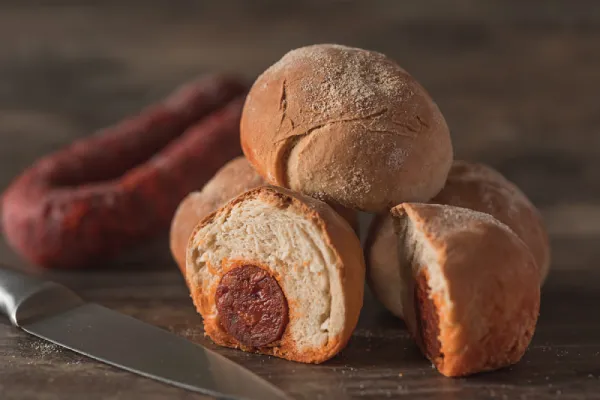If you have ever visited Asturias, you have likely encountered the famous bollo preñao. This chorizo-filled bread roll is a staple at traditional espichas, where cider and local delicacies take center stage. I have enjoyed this dish many times, and I can tell you that the best versions always have a few key secrets. This guide will share my experience and five essential tips to help you make the perfect bollo preñao at home.
Table of Contents
Choosing the Best Chorizo for Authentic Flavor
The heart of a great bollo preñao is the chorizo. While you can use any type, the best results come from authentic Asturian chorizo. This variety has a rich, smoky flavor, often enhanced by the region’s traditional preparation methods.
There are two main options: fresh chorizo and cured chorizo. Fresh chorizo has a softer texture and releases flavorful juices as it cooks inside the dough. Cured chorizo is firmer and imparts a more intense taste. In Asturias, it is common to find versions made with chorizo cooked in cider, which adds an extra flavor depth.
If you want a truly authentic experience, I recommend using fresh Asturian chorizo and, if possible, cooking it in cider before baking.
The Secret to Soft, Fluffy Dough
A great bollo preñao is not just about the filling—the bread must be soft, fluffy, and slightly chewy. Achieving the perfect texture starts with high-quality ingredients and proper kneading.
A basic mixture of flour, yeast, water, olive oil, and salt works well for the dough. However, the secret lies in allowing enough time for the dough to rise. After kneading, let it rest in a warm place until it doubles in size. This step ensures a light and airy texture.
Another key trick is to knead the dough thoroughly. A well-kneaded dough develops gluten, which helps trap air and gives the bread its signature elasticity. If the dough feels too dry, a small drizzle of olive oil can make it more manageable.
When shaping the rolls, seal the chorizo inside properly so the juices don’t escape during baking.
Cooking the Chorizo: Fresh vs. Sidra-Soaked
One of the great debates in making bollo preñao is whether to cook the chorizo before baking or let it cook inside the dough.
Fresh chorizo releases more fat, which soaks into the bread, creating an incredibly flavorful bite. However, this method can sometimes result in a slightly greasy roll.
The alternative is to cook the chorizo in cider (sidra) before wrapping it in dough. This technique, common in Asturias, enhances the flavor while making the chorizo slightly firmer. The acidity of the cider balances the richness of the sausage, making it an excellent choice for a more refined taste.
If you use this method, simmer the chorizo in cider for about 15 minutes before baking. Let it cool slightly before wrapping it in dough.
Baking at the Right Temperature
One of the most common mistakes when making bollo preñao is baking at the wrong temperature. Too low, and the bread becomes dense. Too high, and the crust hardens before the inside is fully cooked.
The ideal baking temperature is around 200°C (390°F). This allows the bread to develop a golden, crispy crust while remaining soft.
Before placing the rolls in the oven, brushing them with beaten egg or milk gives them a beautiful golden finish.
Another important step is preheating the oven properly. A hot oven ensures the dough starts rising immediately, leading to a better texture. Depending on the size of your rolls, baking should take between 15 to 20 minutes.
Serving Bollo Preñao Like a True Asturian
Bollo preñao is not just food; it is part of Asturias’ culture. Traditionally, it is served at espichas and social gatherings where people enjoy cider, cured meats, and other local specialties.
To enjoy it like a true Asturian, serve it warm, straight from the oven. The best pairing is, of course, a glass of natural Asturian cider. The acidity of the cider cuts through the richness of the chorizo, creating the perfect balance.
For a variation, you can also try making bollos preñaos with Cabrales cheese, another Asturian delicacy. While less common than the chorizo version, the combination of strong blue cheese and soft bread is irresistible.
Frequently Asked Questions
1. Can I use another type of sausage instead of chorizo?
You can experiment with other sausages, but traditional Asturian chorizo gives the most authentic flavor. A mild Spanish chorizo or even a smoked sausage could be an alternative.
2. Can I make bollo preñao without yeast?
Yeast is essential for achieving the correct texture. However, if you need a quicker version, you can use baking powder, but the bread will be denser.
3. How do I store leftover bollo preñao?
Store them in an airtight container at room temperature for up to two days. You can also freeze and reheat them in the oven for a fresher taste.
4. Can I make a vegetarian version?
You can fill the bread with cheese, roasted vegetables, or even plant-based sausages for a vegetarian-friendly alternative.
Related Spanish Recipes
If you love bollo preñao, here are some other Spanish dishes you might enjoy:
- Tortilla Española – A traditional Spanish omelet made with eggs, potatoes, and onions.
- Empanadas Gallegas – Delicious stuffed pastries filled with tuna, meat, or vegetables.
- Pan Tumaca – A simple yet flavorful Catalan breakfast dish with bread, tomatoes, garlic, and olive oil.
- Fabada Asturiana – A rich Asturian bean stew with chorizo and morcilla.
- Cachopo – Breaded and stuffed veal fillets, a classic from Asturias.
Conclusion
Making bollo preñao at home is more than just following a recipe—it is about embracing the tradition behind it. By choosing the right chorizo, preparing the dough correctly, and baking at the ideal temperature, you can recreate an authentic Asturian experience in your kitchen.
Whether you serve it at a gathering or enjoy it as a snack with cider, this dish is a true celebration of Spanish flavors. Now that you know the secrets, it is time to try making it yourself.

Bollo Preñao Recipe: 5 Secrets to the Perfect it
Ingredients
For the Dough:
- 500 g (4 cups) All-purpose flour
- 10 g (2 tsps) Salt
- 7 g (1 packet) Dry yeast or 25g fresh yeast
- 250 ml (1 cup) Warm water
- 30 ml (2 tbps) Extra virgin olive oil
- 1 tsp Sugar (to activate the yeast)
For the Filling:
- 6 Fresh Asturian chorizos (or cured Spanish chorizo)
- 250 ml (1 cup) Asturian cider (optional, for cooking the chorizo)
For Brushing:
- 1 Egg yolk (for a golden crust)
Instructions
- Prepare the Dough:In a small bowl, dissolve the yeast and sugar in warm water. Let it sit for 5-10 minutes until it becomes foamy.In a large mixing bowl, combine the flour and salt.Add the yeast mixture and olive oil to the flour. Mix until a dough forms.Knead the dough on a floured surface for about 10 minutes until smooth and elastic.Place the dough in a greased bowl, cover with a clean towel, and let it rise in a warm place for about 1 hour, or until it doubles in size.
- Prepare the Chorizo (Optional: Cook It in Cider):If using fresh chorizo, you can cook it in cider for 15 minutes to enhance the flavor. This step is optional but highly recommended.Let the chorizo cool before placing it inside the dough.
- Assemble the Bollos Preñaos:Once the dough has risen, punch it down and divide it into 6 equal portions.Flatten each portion into an oval shape and place a chorizo in the center.Wrap the dough around the chorizo, sealing the edges to prevent juices from leaking.Place the rolls on a baking sheet lined with parchment paper.
- Bake to Perfection:Preheat the oven to 200°C (390°F).Brush each roll with beaten egg yolk for a golden, glossy finish.Bake for 15-20 minutes, or until golden brown and fully cooked.
Notes
Serving & Storage
- Serve warm with a glass of Asturian cider for an authentic experience.
- Store leftovers in an airtight container at room temperature for up to 2 days.
- Reheat in the oven at 180°C (350°F) for 5-7 minutes to restore freshness.
- Freeze for up to 3 months and thaw before reheating.






